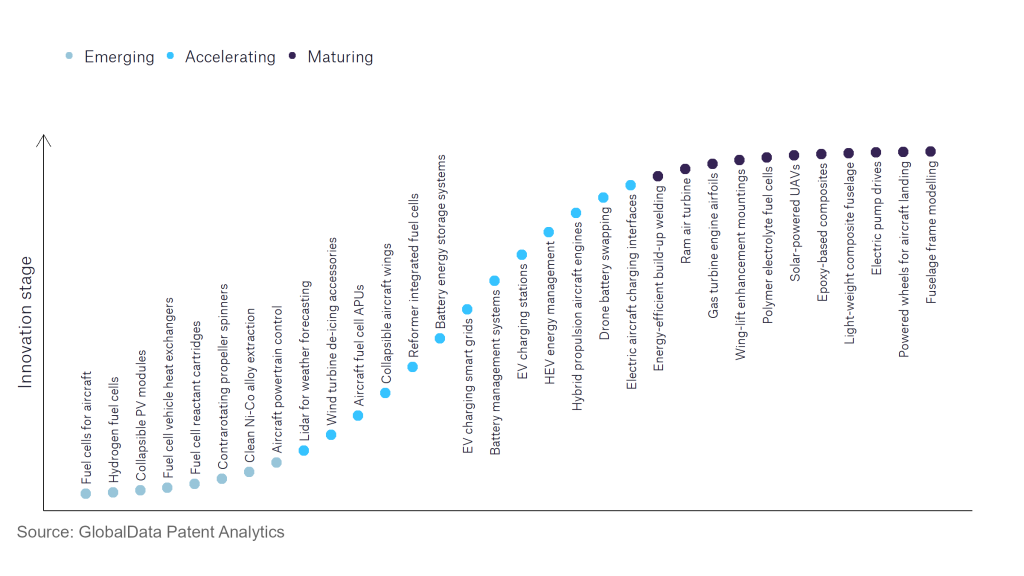The aerospace and defence industry continues to be a hotbed of innovation, with activity driven by the need to lower operational costs, broad consumer trends, and electrification, and growing importance of technologies such as hydrogen and electric aircraft and advanced materials. In the last three years alone, there have been over 174,000 patents filed and granted in the aerospace and defence industry, according to GlobalData’s report on Environment Sustainability in Aerospace, Defence & Security: HEV energy management. Buy the report here.
However, not all innovations are equal and nor do they follow a constant upward trend. Instead, their evolution takes the form of an S-shaped curve that reflects their typical lifecycle from early emergence to accelerating adoption, before finally stabilising and reaching maturity.
Identifying where a particular innovation is on this journey, especially those that are in the emerging and accelerating stages, is essential for understanding their current level of adoption and the likely future trajectory and impact they will have.
180+ innovations will shape the aerospace and defence industry
According to GlobalData’s Technology Foresights, which plots the S-curve for the aerospace and defence industry using innovation intensity models built on over 262,000 patents, there are 180+ innovation areas that will shape the future of the industry.
Within the emerging innovation stage, hydrogen fuel cells, and fuel cells for aircraft are disruptive technologies that are in the early stages of application and should be tracked closely. EV charging stations, collapsible aircraft wings, and electric aircraft charging interfaces are some of the accelerating innovation areas, where adoption has been steadily increasing. Among maturing innovation areas are fuselage frame modelling and powered wheels for aircraft landing, which are now well established in the industry.
Innovation S-curve for environmental sustainability in the aerospace and defence industry

HEV energy management is a key innovation area in environmental sustainability
An Energy Management Strategy (EMS) is a key link in the HEV/PHEV design process, solving energy distribution problems to control the flow of energy between fuel tanks and electrical energy storage.
GlobalData’s analysis also uncovers the companies at the forefront of each innovation area and assesses the potential reach and impact of their patenting activity across different applications and geographies. According to GlobalData, there are 120+ companies, spanning technology vendors, established aerospace and defence companies, and up-and-coming start-ups engaged in the development and application of HEV energy management.
Key players in HEV energy management – a disruptive innovation in the aerospace and defence industry
‘Application diversity’ measures the number of different applications identified for each relevant patent and broadly splits companies into either ‘niche’ or ‘diversified’ innovators.
‘Geographic reach’ refers to the number of different countries each relevant patent is registered in and reflects the breadth of geographic application intended, ranging from ‘global’ to ‘local’.
Patent volumes related to HEV energy management
Source: GlobalData Patent Analytics
Boeing is one of the leading patent filers in HEV energy management. Boeing is investing heavily in the technology, an essential component in hybrid propulsion, as the company seeks to develop hybrid-propulsion aircraft in the medium term. The company is involved in NASA’s Electric Powertrain Flight Demonstration (EPFD) project. The five-year, $260 million effort is being funded by investments from NASA, GE Aviation, Boeing and other partners. Other leading patent filers in the aerospace and defence industry include Rolls-Royce, Raytheon Technologies, Airbus, and Safran.
In terms of application diversity, Wisk Aero is the leading company followed by Raytheon Technologies and Solar Ship. Regarding geographic reach, Solar Ship held the top position, trailed by Safran and Rolls-Royce in second and third position, respectively.
HEV energy management is a key enabling technology for the rollout of hybrid-propulsion across all industries, including in aerospace. In light of this, firms seeking to carve out a niche in a future green aviation market are investing in the technology.
To further understand how electric vehicles are disrupting the aerospace and defence industry, access GlobalData’s latest thematic research report on Thematic Research - Electric Vehicles in Defence.
Data Insights
From

The gold standard of business intelligence.
Blending expert knowledge with cutting-edge technology, GlobalData’s unrivalled proprietary data will enable you to decode what’s happening in your market. You can make better informed decisions and gain a future-proof advantage over your competitors.



